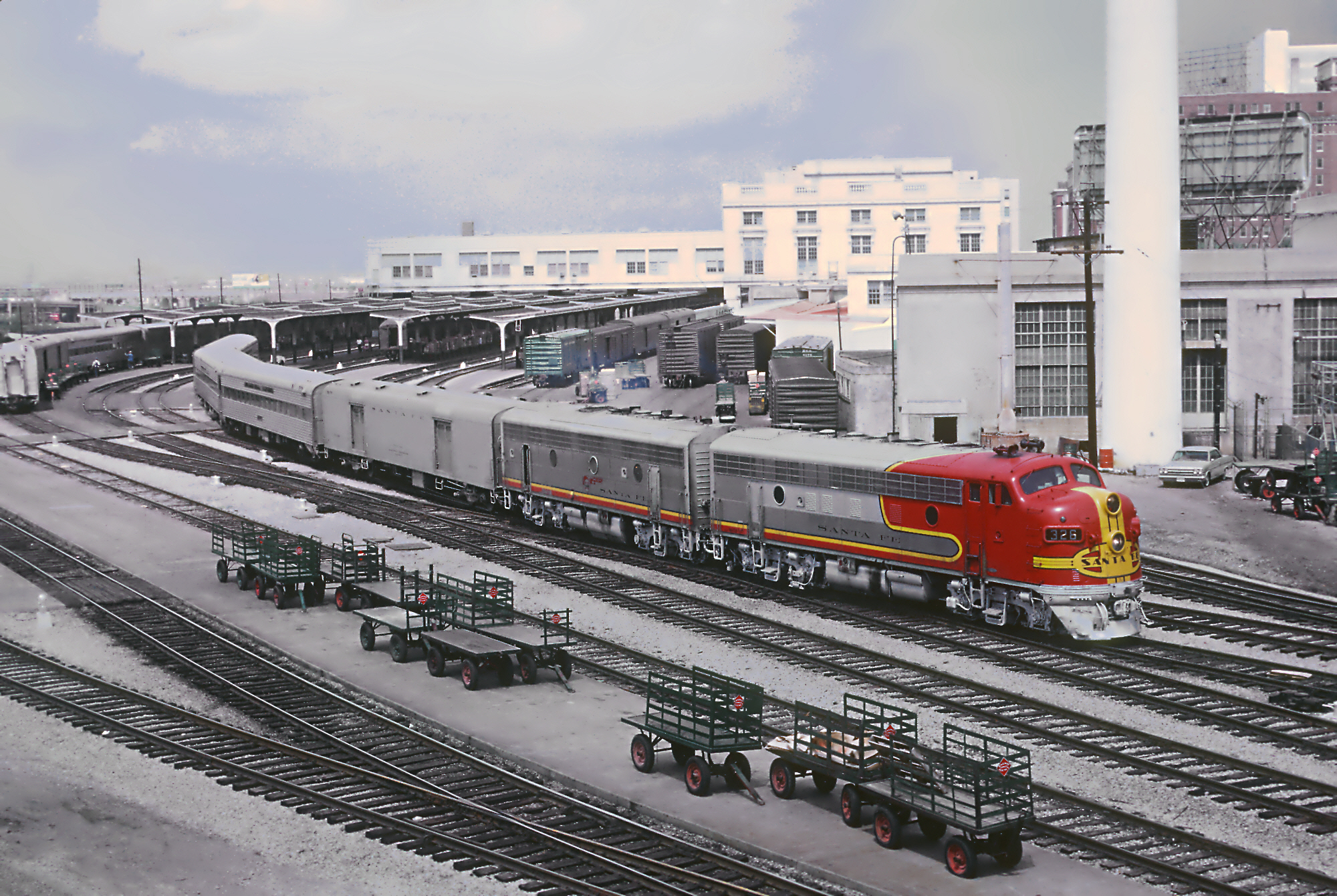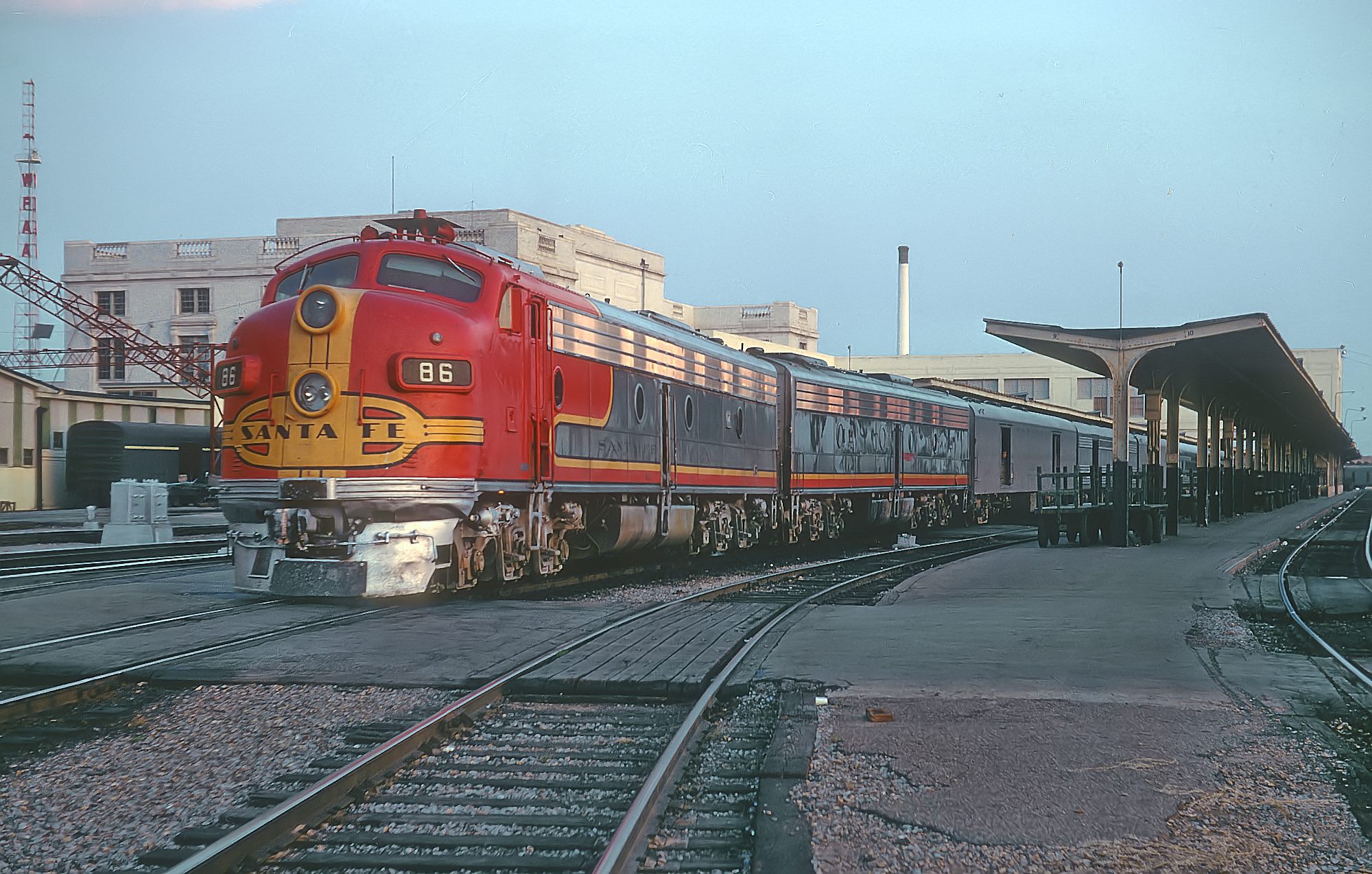Dallas Union Station, The City's Passenger Hub Since 1916
Published: July 23, 2024
By: Adam Burns
Dallas Union Station, also known as Dallas Union Terminal and Eddie Bernice Johnson Union Station, is a historic train station located in Dallas, Texas.
It serves as a major hub for the city's public transportation system, including Amtrak, Trinity Railway Express, and the Dallas Area Rapid Transit (DART) light rail system.
The station, which opened in 1916, is noted for its Beaux-Arts architecture and is listed on the National Register of Historic Places.
Photos
 This historic view of Dallas Union Station features Santa Fe's train #116, the Dallas section of the "Texas Chief," departing the terminal on March 25, 1967. Roger Puta photo.
This historic view of Dallas Union Station features Santa Fe's train #116, the Dallas section of the "Texas Chief," departing the terminal on March 25, 1967. Roger Puta photo.Construction and Cost
The Union Terminal Company constructed the Dallas Union Terminal, originally known as Union Station, in 1916 to centralize five dispersed rail stations in Dallas, marking it as a major transportation hub in the Southern United States.
At its peak, Union Station accommodated up to 80 trains daily. Designed by prominent architect Jarvis Hunt, known for his work on other significant train stations, the terminal served an array of railroads, including the Santa Fe, St. Louis Southwestern Railway (Cotton Belt), Fort Worth & Denver Railway, Chicago, Rock Island and Pacific Railroad (Rock Island), Burlington-Rock Island Railroad, St. Louis and San Francisco Railway (Frisco), Missouri–Kansas–Texas Railroad (Katy), Southern Pacific Railroad, and Texas & Pacific Railway.
This historical landmark officially opened its doors to an intrigued public on October 14, 1916. With great fanfare, the residents of Dallas observed the station bustling into full operation, marking the inception of a new chapter in their city's transport story.
The Dallas Union Station was constructed at a cost of $1.3 million, a significant financial undertaking reflective of its monumental scale and pivotal role in transportation.
Architectural Style
The station is an elegant embodiment of the Beaux-Arts architectural style. It was designed with a three-story main waiting room adorned with ornamental plaster ceilings, a careful precision that commands admiration for its beauty and historical significance.
The locally quarried red Texas granite and terracotta trim—or 'architectural ceramics'—infuse the station with a majestic aura. It is a testament to the grandeur of material quality and construction techniques of its time.
Located at 400 South Houston Street, the station served as a gateway connecting Dallas to numerous destinations, making it an integral part of Dallas' city plan.
The facility initially boasted 7 tracks and 2 island platforms, accommodating the efficient movement of passengers and trains. It was an impressive setup that facilitated smooth conduct of operations.
Peak Years
At its zenith in the 1940s, the station facilitated the movement of an estimated 80 trains daily, serving a multitude of passengers. Operating at high capacity, it played a pivotal role in the bustling railway traffic of the time.
Some of the notable trains one could witness from the station platforms included the Texas Zephyr, Texas Eagle, Texas Chief, Texas Rocket, and Texas Special.
Initially, the station's second-level waiting room connected to train platforms via an overhead walkway, which proved unpopular due to the numerous stairs.
Escalators were added, but eventually, the Grand Hall was abandoned in favor of a renovated ticketing area and waiting room on the ground floor, which remains in use today.
An underground corridor replaced the walkway, providing ramps at each platform. Despite Dallas being the second most populous city in Texas at the time, the station's prominence was somewhat overshadowed by Fort Worth Union Station. For example, the Rock Island's Twin Star Rocket from Minneapolis terminated in Fort Worth rather than Dallas, and the Santa Fe's Texas Chief from Chicago also routed through Fort Worth to Houston.
The last passenger train to serve Union Station before Amtrak's was the Missouri Pacific's Texas Eagle, which departed on May 31, 1969.
 Santa Fe E8Am #86L, rebuilt in May, 1953 from a former E1A, has Texas & Pacific (Missouri Pacific) Train #501 at Dallas Union Station in September, 1970. This particular train ferried Santa Fe equipment from the temrinal to Fort Worth's Union Depot. From there, cars were sent north via the "Kansas Cityan"/"Chicagoan" and/or west via the "California Special." Tom Hoffmann photo, Rick Burn collection.
Santa Fe E8Am #86L, rebuilt in May, 1953 from a former E1A, has Texas & Pacific (Missouri Pacific) Train #501 at Dallas Union Station in September, 1970. This particular train ferried Santa Fe equipment from the temrinal to Fort Worth's Union Depot. From there, cars were sent north via the "Kansas Cityan"/"Chicagoan" and/or west via the "California Special." Tom Hoffmann photo, Rick Burn collection.Amtrak Era
When Amtrak commenced operations in the spring of 1971, it initially consolidated most Metroplex services in Fort Worth but planned to extend services to Dallas contingent upon improvements at Union Terminal.
With those upgrades completed, Amtrak service began on March 14, 1974, with the Inter-American running between St. Louis and Laredo, eventually evolving into today's Texas Eagle. Additionally, from 1975 to 1981, the station was served by the Lone Star, a successor to the Santa Fe's Texas Chief.
Currently, Union Station serves as a bustling service point for three prominent Amtrak trains—the Texas Eagle, Heartland Flyer, and Sunset Limited. These trains effectively connect Dallas with numerous states across America.
Union Station underwent major renovation phases in 1954 and then again in 2008. These refurbishment efforts ensured its preservation and adaptation to modern-day requirements, a testament to Dallas's commitment to safeguard its cultural icons.
It plays a significant role in Dallas' urban transit. Union Station is currently utilized by the Trinity Railway Express, connecting the bustling cities of Dallas and Fort Worth. It's an integral nexus of the train's daily schedule.
Simultaneously, it also serves as a crucial hub for the Dallas Area Rapid Transit (DART) Light Rail lines, offering comprehensive local transit solutions to Dallas' residents and visitors.
Today
In fiscal year 2022, Dallas Union Station witnessed nearly 135,000 passengers making use of its services—an astounding figure showcasing its pivotal role in the city's transportation infrastructure.
Aesthetically, the Beaux-Art inspired beacon room and its adjoining connected lobbies capture the visitor's imagination with their grandeur. The intricate detailing mirrors the architect Jarvis Hunt’s determination to blend function with form.
Recent Articles
-
Florida Scenic Train Rides In Parrish!
Jan 11, 26 02:59 PM
The Florida Railroad Museum (FRRM) in Parrish offers something increasingly rare in today’s rail landscape: a chance to ride historic equipment over a surviving fragment of an early-20th-century mainl… -
California's - Wine Tasting - Train Rides
Jan 11, 26 02:28 PM
This article explores the charm, routes, and offerings of these unique wine tasting trains that traverse California’s picturesque landscapes. -
Georgia's - Murder Mystery - Dinner Train Rides
Jan 11, 26 02:07 PM
In the heart of the Peach State, a unique form of entertainment combines the thrill of a murder mystery with the charm of a historic train ride. -
Colorado ~ Murder Mystery ~ Dinner Train Rides
Jan 11, 26 01:43 PM
Nestled among the breathtaking vistas and rugged terrains of Colorado lies a unique fusion of theater, gastronomy, and travel—a murder mystery dinner train ride. -
Minnesota Dinner Train Rides In Duluth!
Jan 11, 26 01:32 PM
One of the best ways to feel the region's history in motion today is aboard the North Shore Scenic Railroad (NSSR), which operates out of Duluth’s historic depot. -
Illinois Dinner Train Rides At Monticello!
Jan 11, 26 12:42 PM
the Monticello Railway Museum (MRM) is one of those places that quietly does a lot: it preserves a sizable collection, maintains its own operating railroad, and—most importantly for visitors—puts hist… -
Alabama's - Wine Tasting - Train Rides
Jan 10, 26 09:29 AM
While the state might not be the first to come to mind when one thinks of wine or train travel, the unique concept of wine tasting trains adds a refreshing twist to the Alabama tourism scene. -
Maryland Dinner Train Rides At WMSR!
Jan 10, 26 09:13 AM
The Western Maryland Scenic Railroad (WMSR) has become one of the Mid-Atlantic’s signature heritage operations—equal parts mountain railroad, living museum, and “special-occasion” night out. -
Arkansas Dinner Train Rides On The A&M!
Jan 10, 26 09:11 AM
If you want a railroad experience that feels equal parts “working short line” and “time machine,” the Arkansas & Missouri Railroad (A&M) delivers in a way few modern operations can. -
South Dakota's - Murder Mystery - Dinner Train Rides
Jan 10, 26 09:08 AM
While the state currently does not offer any murder mystery dinner train rides, the popular "1880 Train" at the Black Hills Central recently hosted these popular trips! -
Wisconsin's - Murder Mystery - Dinner Train Rides
Jan 10, 26 09:07 AM
Whether you're a fan of mystery novels or simply relish a night of theatrical entertainment, Wisconsin's murder mystery dinner trains promise an unforgettable adventure. -
Missouri's - Murder Mystery - Dinner Train Rides
Jan 10, 26 09:05 AM
Missouri, with its rich history and scenic landscapes, is home to one location hosting these unique excursion experiences. -
Washington ~ Murder Mystery ~ Dinner Train Rides
Jan 10, 26 09:04 AM
This article delves into what makes murder mystery dinner train rides in Washington State such a captivating experience. -
Kentucky Scenic Train Rides At KRM!
Jan 09, 26 11:13 PM
Located in the small town of New Haven the Kentucky Railway Museum offers a combination of historic equipment and popular excursions. -
Washington "Wine Tasting" Train Rides
Jan 09, 26 08:53 PM
Here’s a detailed look at where and how to ride, what to expect, and practical tips to make the most of wine tasting by rail in Washington. -
Kentucky's - Wine Tasting - Train Rides
Jan 09, 26 08:21 PM
Kentucky, often celebrated for its rolling pastures, thoroughbred horses, and bourbon legacy, has been cultivating another gem in its storied landscapes; enjoying wine by rail. -
Kentucky's - Murder Mystery - Dinner Train Rides
Jan 09, 26 01:12 PM
In the realm of unique travel experiences, Kentucky offers an enchanting twist that entices both locals and tourists alike: murder mystery dinner train rides. -
Utah's - Murder Mystery - Dinner Train Rides
Jan 09, 26 01:05 PM
This article highlights the murder mystery dinner trains currently avaliable in the state of Utah! -
North Carolina Dinner Train Rides At NCTM!
Jan 09, 26 12:51 PM
Tucked into the Piedmont town of Spencer, the North Carolina Transportation Museum is the kind of place that feels less like a typical museum and more like a living rail yard that never quite stopped… -
Tennessee Dinner Train Rides At The TVRM!
Jan 09, 26 12:39 PM
Tucked into East Chattanooga, the Tennessee Valley Railroad Museum (TVRM) is less a “museum you walk through” and more a railroad you step aboard.



















